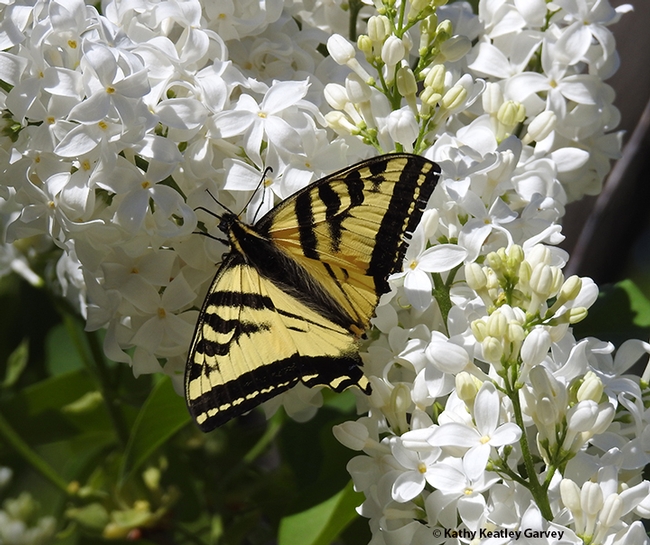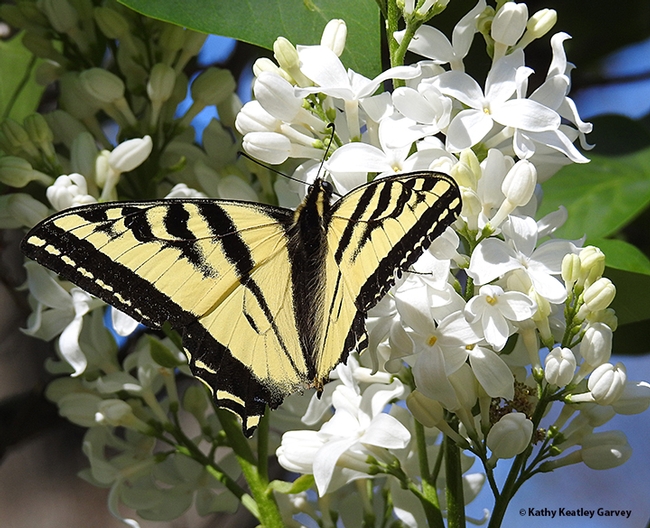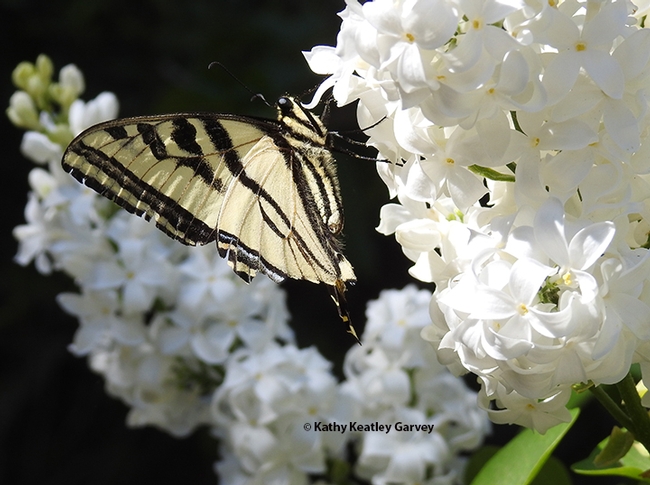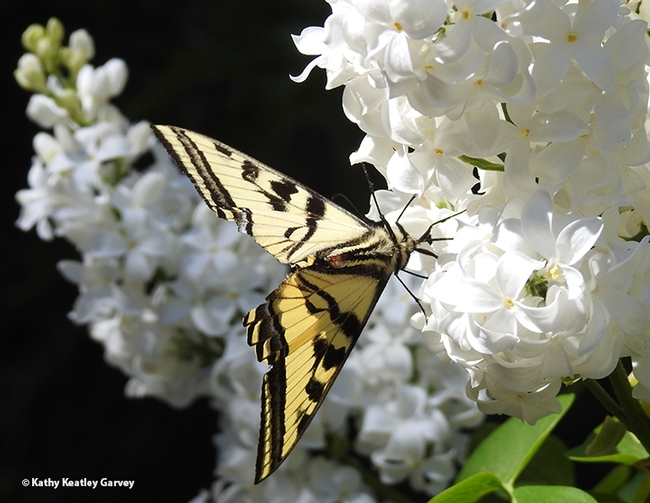- Author: Kathy Keatley Garvey
When a newly eclosed Western tiger swallowtail, Papilio rutulus, lands on a butterfly bush, the colors are striking.
The yellow and black butterfly contrasts well on the purple blossoms of Buddleja davidii.
While the majestic butterfly is widely loved, the plant, also called summer lilac, is not. It's considered an ecological threat and a noxious weed by the Invasive Plant Atlas of the United States: "Buddleja davidii readily invades disturbed sites and riparian areas. Although butterflies will use this plant as a nectar source their larvae cannot survive on it. By replacing native larval food source plants butterfly bush can have a negative impact on wildlife."
B. davidii is native to Sichuan and Hubei provinces in central China, and also Japan. The genus, Buddleja, is named for the Rev. Adam Buddle, an English botanist. The species name honors Father Armand David, a French missionary and explorer in China, Father Armand David, who was the first European to report the shrub, according to Wikipedia. It won the RHS Award of Merit in 1898, and the Award of Garden Merit (AGM) in 1941.
Now nurseries are selling non-invasive hybrids, with such names as "Lo and Behold" and "Blue Chip" and "Flutterby."
Nevertheless, who can resist photographing the Western tiger swallowtail as it stops to nectar on a butterfly bush?
Lo and behold...
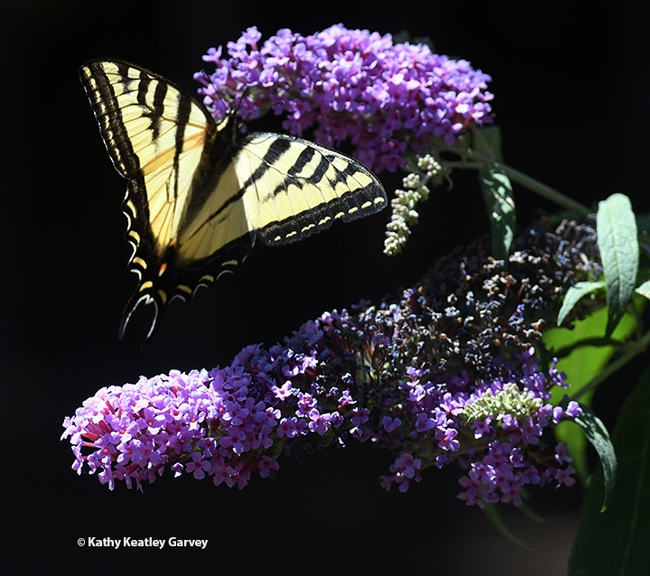
- Author: Kathy Keatley Garvey
It's not "officially" spring until we see--and photograph--the spectacular Western tiger swallowtail, Papilio rutulus.
That's what I posted April 2, 2021 on Bug Squad after seeing one land March 30 on a white lilac bush in a Vacaville park. It lingered long enough for a few photos and then fluttered away.
This butterfly's wings are a brilliant yellow with black stripes. Blue and orange spots accent the "tails" on its hindwings.
Fast forward to today: The Entomological Society of America (ESA) has before its members, a proposal to add the common name, "Western Tiger Swallowtail,” to the scientific name, Papilio rutulus.
Most of us have not called it anything else. Oh, wait, there was "That Big Yellow Gorgeous Butterfly" and "Ol' Yeller" and "Sunshine Butterfly."
The ESA-approved name, if the members agree, would be "Western tiger swallowtail." Yes!
Presently there are 10 species within the family Papilionidae that have common names established by ESA. None describe species that are primarily found west of the Mississippi.
"Western" reflects its broad distribution over the western United States, as ESA says. "It is the most abundant of the 'tiger swallowtails' in this part of the U.S., paralleling the distribution of Papilio glaucus (tiger swallowtail/'eastern tiger swallowtail') which is the most abundant species in the eastern United States."
Also up for discussion and approval are these proposals for common names:
- "Two-tailed swallowtail" for Papilio multicaudata
- "Eastern tiger swallowtail" for Papilio glaucus
- "Pale swallowtail" for Papilio eurymedon
See the ESA database of common names, which includes more than 2,000 common names of insects and is searchable by common name, scientific name, author, order, family, genus, and species.
Butterfly guru Art Shapiro, UC Davis distinguished professor of evolution and ecology who maintains a research site, Art's Butterfly World," monitoring the butterfly populations in Central California since 1972, has always called Papilio rutulus by the common name of Western tiger swallowtail. But mostly he calls it Papilio rutulus. He writes on his website:
"The Western Tiger Swallowtail is basically a species of riparian forest, where it glides majestically back and forth along the watercourse. It has expanded into older urban neighborhoods where several of its host genera are grown as shade trees, and behaves as if the street were a watercourse. In the high country and on the Sierran east slope its usual host is Aspen."
"One brood (June-July) at higher elevations; one and a partial second at Washington; 2-3 at lower elevations with a long flight season (late February or March-September or October). An avid puddler. Visits Yerba Santa, California Buckeye, Milkweed, Dogbane, Lilies, Coyotemint, etc., etc. and in gardens frequent at Lilac and Buddleia. Spring individuals are smaller and usually paler than summer. Low-elevation hosts include Sycamore (Platanus), Ash (Fraxinus), Cherry and other stone fruits (Prunus), Willow (Salix), Privet (Ligustrum), Lilac (Syringa) and (in Sacramento County) Sweet Gum (Liquidambar)."
Have you seen any Papilio rutulus this year? Or the Western tiger swallowtail? Or "That Big Yellow Gorgeous Butterfly?"

- Author: Kathy Keatley Garvey
Are you tired of the triple-digit temperatures? Wish someone would throw a breeze your way and provide a little shade?
A honey bee foraging on a Mexican sunflower (Tithonia rotundifola) probably felt a slight breeze when a Western tiger swallowtail (Papilio rutulus) fluttered down and landed next to her.
This is a two-insect blossom now.
Butterfly: "Bee, what are you doing?"
Bee: "Sipping some nectar, same as you."
Butterfly: "Bee, don't get any closer."
Bee, edging closer. "But I was here first. The nectar is excellent."
Butterfly: "Go away."
Bee: "No."
Butterfly: "Then I will." The butterfly lifts off.
Bee: "Thanks for the shade. You make a good umbrella, Madam Butterfly. Come back anytime."
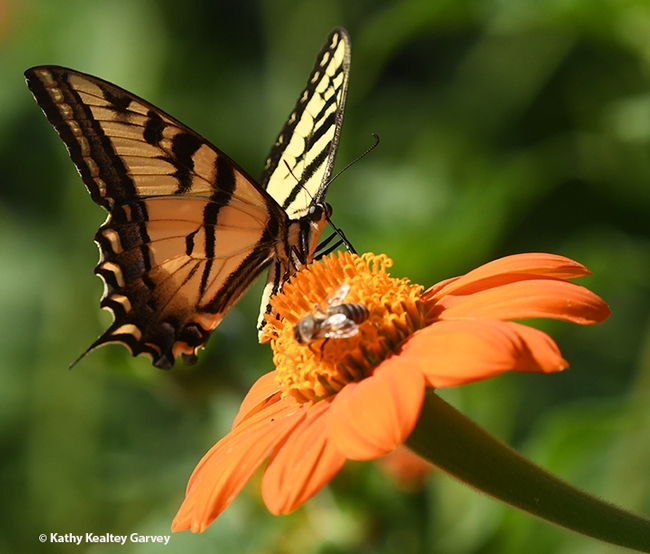
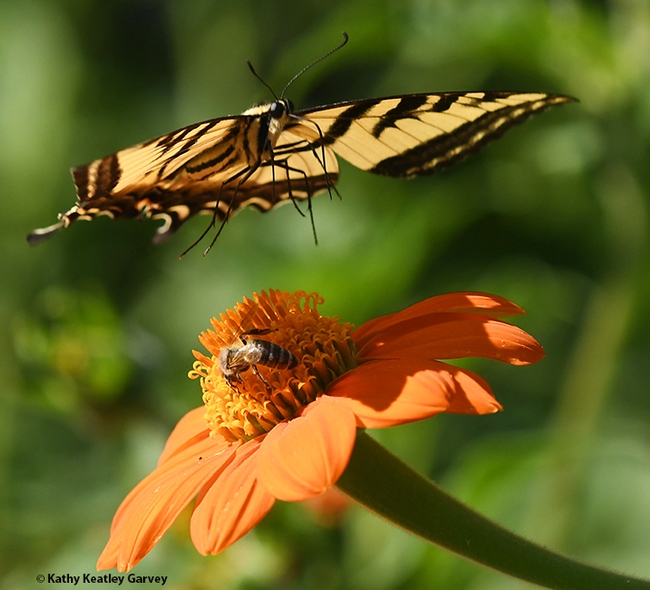
- Author: Kathy Keatley Garvey
It's Day 3 of National Pollinator Week.
Fortunately, a tiger came to visit us--no, not the predatory jungle animal, Panthera tigris, but a newly emerged Western tiger swallowtail, Papilio rutulus.
This native butterfly is quite colorful, with black stripes accenting its brilliant yellow wings, and blue and orange spots gracing its tail. When it flutters into your garden, you stop everything you're doing and become a professional butterfly watcher until it leaves. It's the law, I think. Anyway, Western tiger swallowtails are almost hypnotic.
This fluttering tiger took a liking to our Mexican sunflower, Tithonia rotundifola, and was totally unaware of a tiny longhorned bee, a male Melissodes agilis, heading straight for it.
Pretend you're the butterfly. Here you are, newly emerged and you've discovered a patch of Tithonia offering delicious nectar! Heaven scent! Then you see a speedy little critter targeting you. He's not about to make a lane change. There's no garden patrol to monitor his speed or aggressive behavior. He's coming for you. He aims to hit you and dislodge you from your perch.
This little bee, in fact, targets all critters occupying "his" flowers. He isn't out to sting the floral occupants, as one reader surmised. It's a male bee, and boy bees can't sting. Nor is he fighting over pollen. Males do not collect pollen or nectar for their colony--the females do.
So what is he doing? He's trying to protect or save the floral resources for the females of the species so he can mate with them. The late Robbin Thorp, noted bee expert and distinguished emeritus professor of entomology at UC Davis, used to talk about these little guys bullying all the floral tenants--from Valley carpenter bees to majestic monarchs to praying mantids. Sometimes an unfortunate Melissodes winds up in the spiked forelegs of a mantis. Or in the clutches of a spider. Or in the beak of a bird.
It's a jungle out there. Sometimes it's the survival of the fittest. Or the flittest.
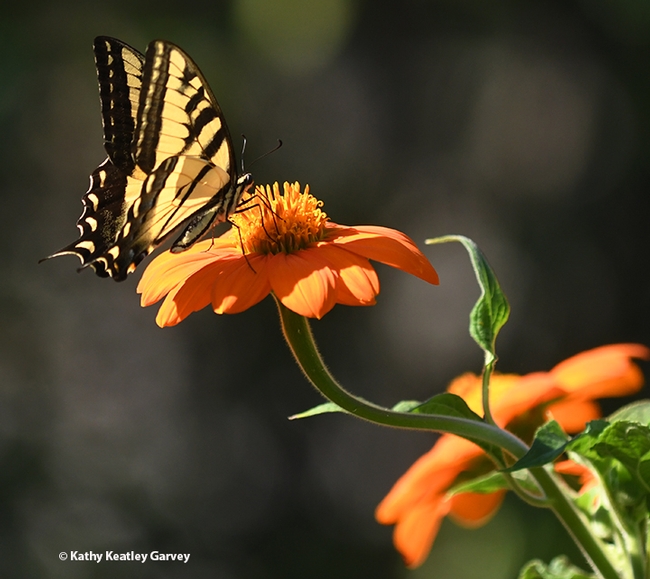
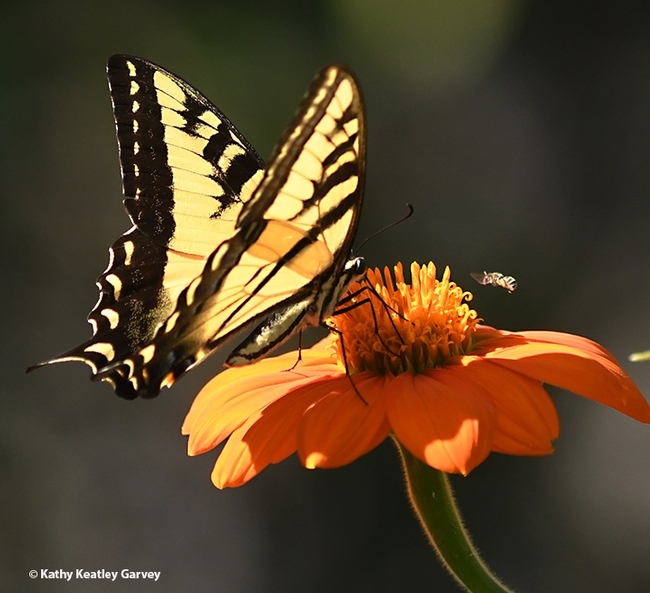
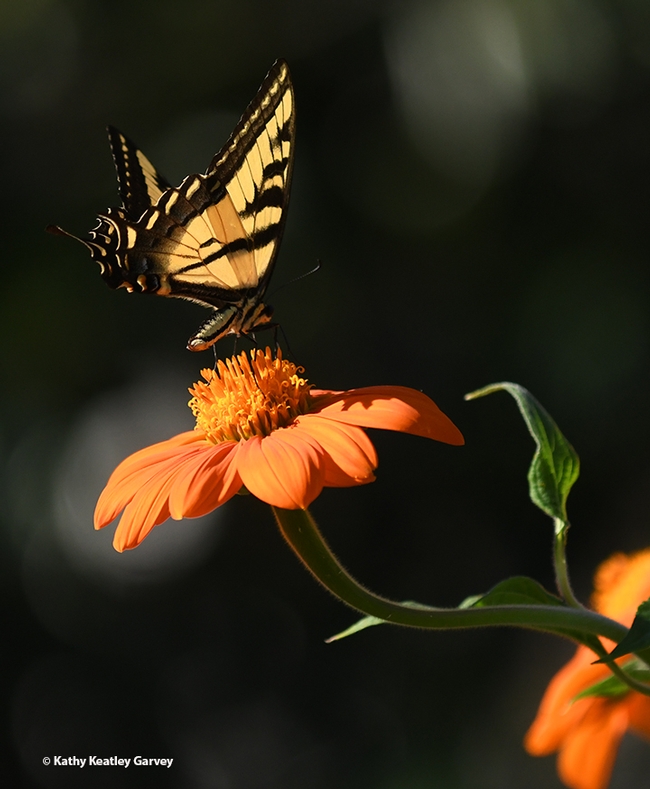
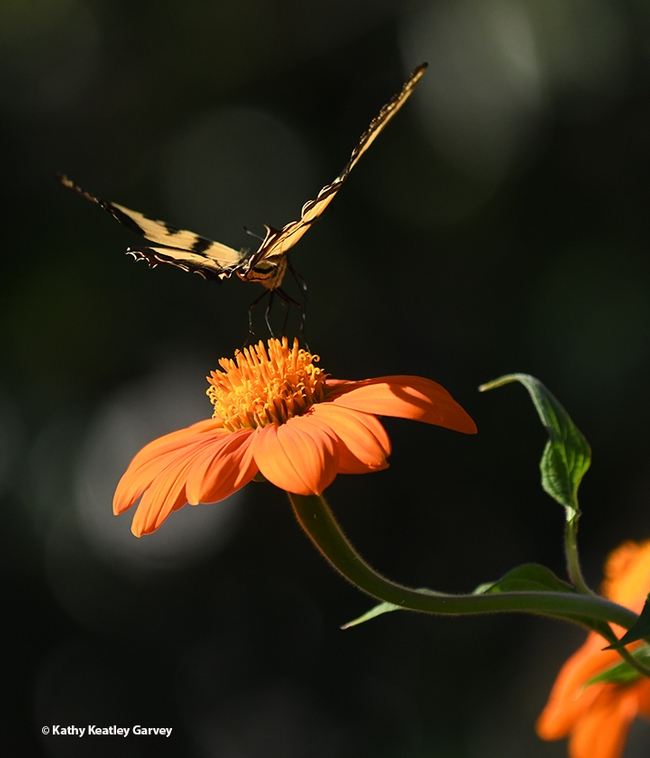
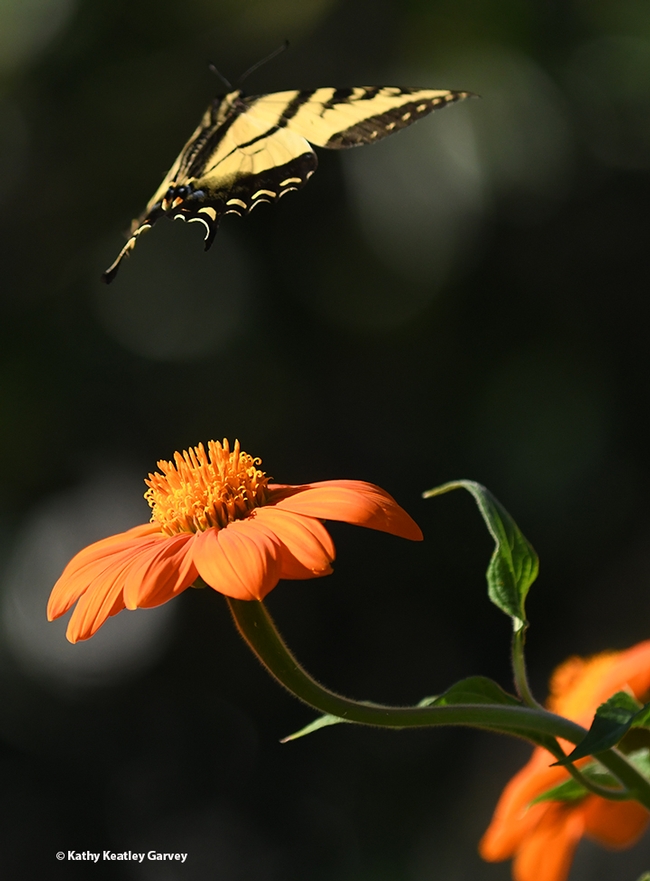
- Author: Kathy Keatley Garvey
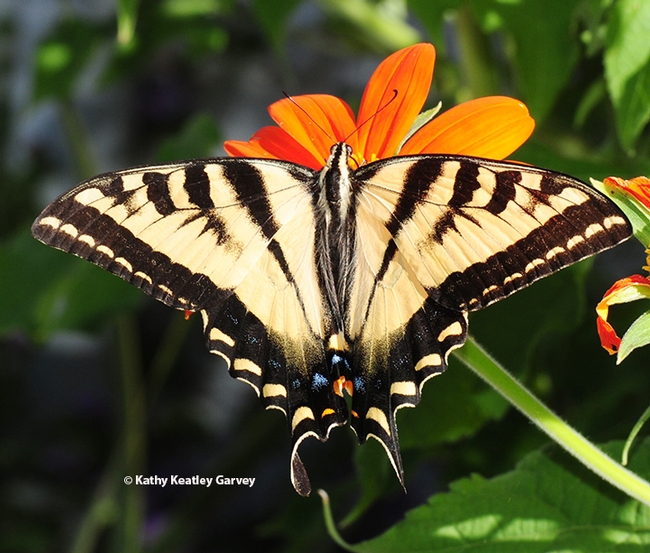
It's not "officially" spring until we see--and photograph--the spectacular Western tiger swallowtail, Papilio rutulus.
One landed March 30 on an aromatic white lilac bush in Alamo Creek Park, Vacaville. It lingered long enough for a few photos and then fluttered away.
Butterfly guru Art Shapiro, UC Davis distinguished professor, Department of Evolution and Ecology, saw his first Papilio rutulus of the year on March 4 in Davis. Butterfly enthusiast and naturalist Greg Kareofelas, an associate of the Bohart Museum of Entomology, UC Davis, saw his first on March 23, also in Davis, "and since then, I've been seeing them regularly."
This butterfly's wings are a brilliant yellow with black stripes. Blue and orange spots accent "the tails" on their hindwings. The one we saw in Vacaville was missing some of its "parts," probably due to a close encounter with a predator, maybe a California scrub jay seeking a quick meal.
Professor Shapiro writes on his website: "The Western Tiger Swallowtail is basically a species of riparian forest, where it glides majestically back and forth along the watercourse. It has expanded into older urban neighborhoods where several of its host genera are grown as shade trees, and behaves as if the street were a watercourse. In the high country and on the Sierran east slope its usual host is Aspen."
"One brood (June-July) at higher elevations; one and a partial second at Washington; 2-3 at lower elevations with a long flight season (late February or March-September or October). An avid puddler. Visits Yerba Santa, California Buckeye, Milkweed, Dogbane, Lilies, Coyotemint, etc., etc. and in gardens frequent at Lilac and Buddleia. Spring individuals are smaller and usually paler than summer. Low-elevation hosts include Sycamore (Platanus), Ash (Fraxinus), Cherry and other stone fruits (Prunus), Willow (Salix), Privet (Ligustrum), Lilac (Syringa) and (in Sacramento County) Sweet Gum (Liquidambar)."
Check out Shapiro's newly renovated website at https://butterfly.ucdavis.edu. The work of webmaster Dave Waetjen, it's a must-see and must-read. A colorful male monarch graces the home page.
Shapiro has monitored butterfly populations across central California for more than 45 years. It's part of his continuing effort to regularly monitor butterfly population trends on a transect across central California. "Ranging from the Sacramento River delta, through the Sacramento Valley and Sierra Nevada mountains, to the high desert of the western Great Basin, fixed routes at ten sites have been surveyed at approximately two-week intervals since as early as 1972. The sites represent the great biological, geological, and climatological diversity of central California."
And one of the species is the spectacular Western tiger swallowtail, which Shapiro monitors at all 10 of his sites.
Hello, spring!
